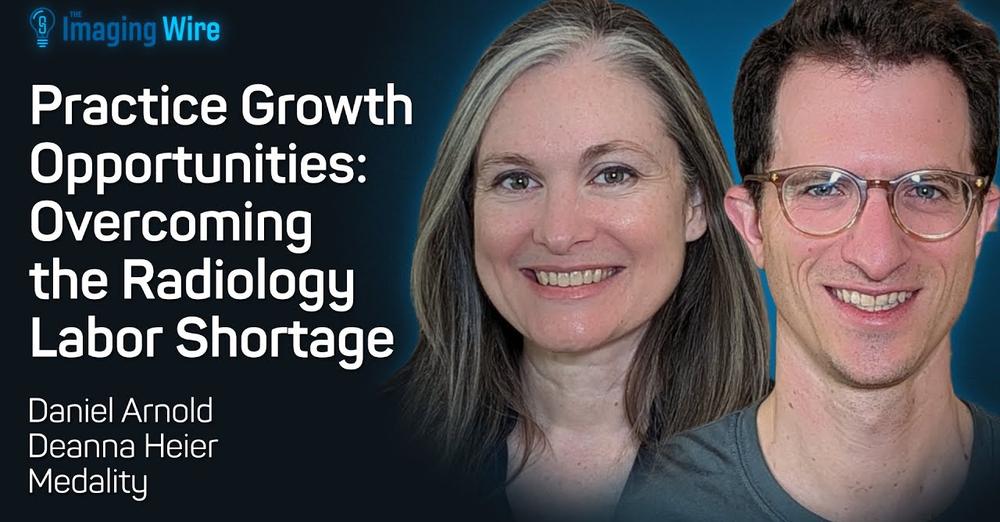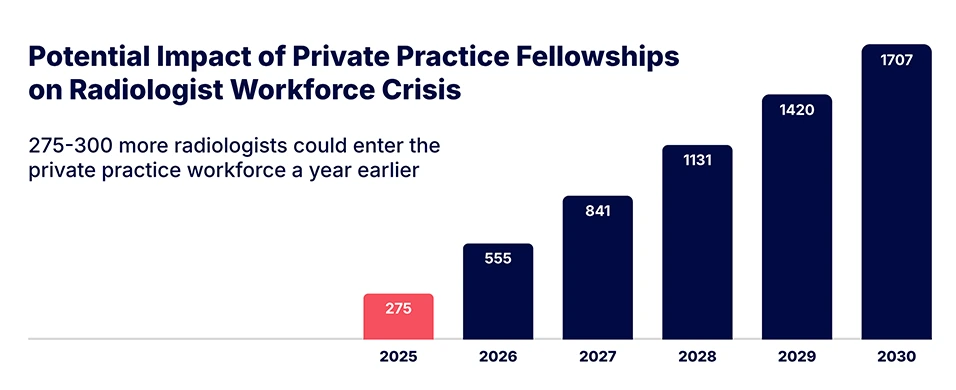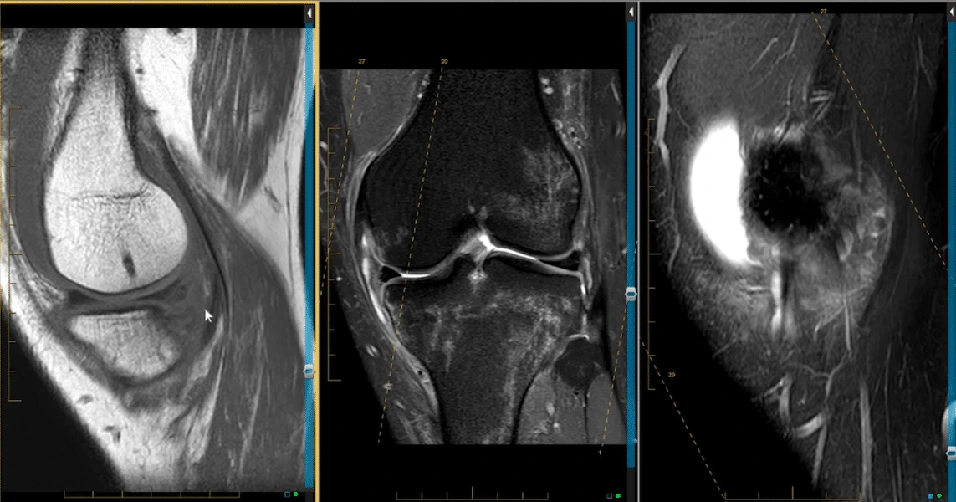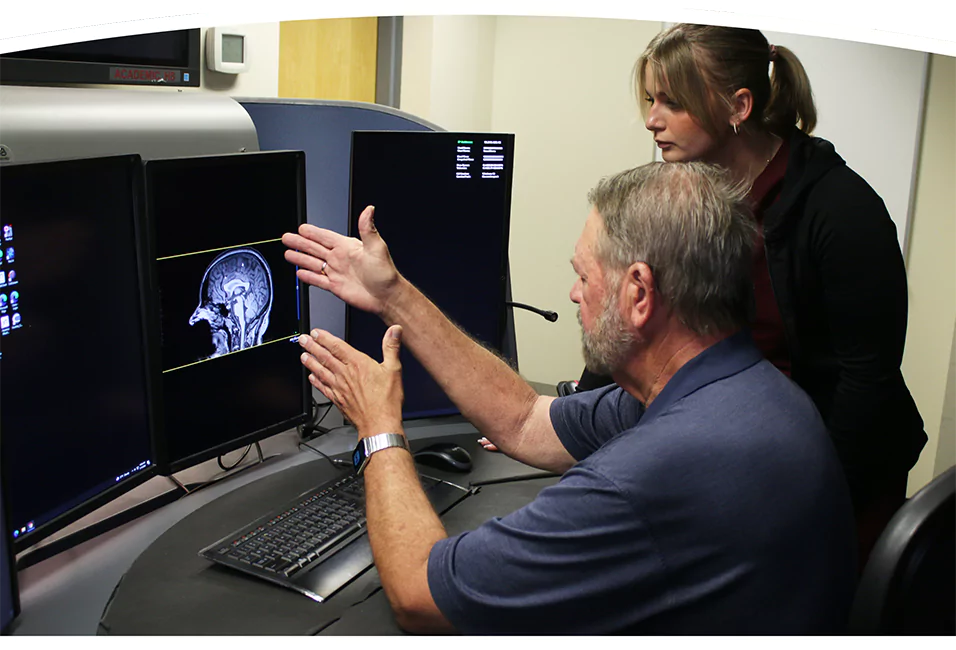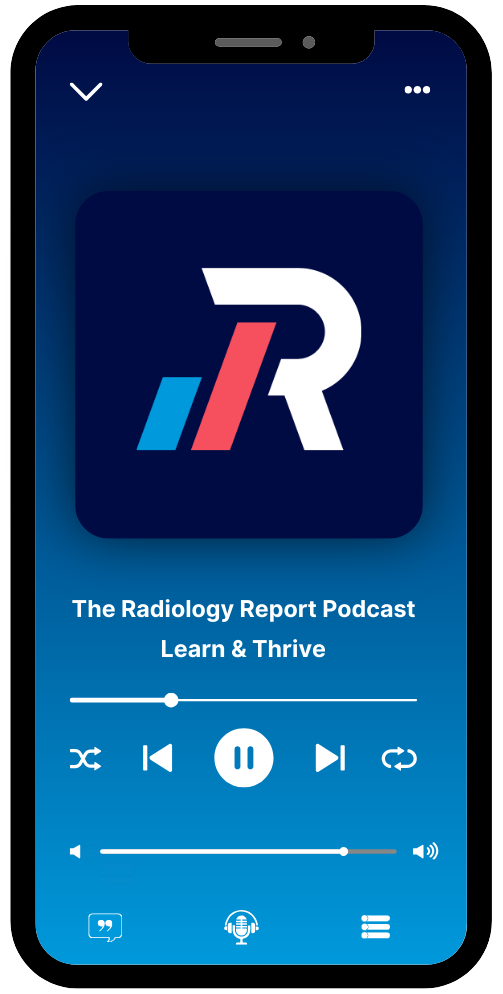Medality CEO and Co-Founder, Daniel Arnold, and VP of Educational Strategy and Operations, Deanna M. Heier, PhD recently chatted with The Imaging Wire to discuss how practices can take advantage of growth opportunities, despite the radiology labor shortage, by helping their radiologists upskill in critical areas.
Transcript
Brian Casey: Hello and welcome to the Imaging Wire Show. My name is Brian Casey and I'm Managing Editor of the Imaging Wire. We've got a great episode for you today. Our topic is Practice Growth Opportunities: Overcoming the Radiology Labor Shortage and our guests are Daniel Arnold, CEO and Co-founder of online education company Medality and Deanna Heier, PhD, Medality’s Vice President of Educational Strategy and Operations.
Dan and Deanna, thanks for being with us today.
Daniel Arnold: Thanks for having us on the show, Brian. I've been an avid reader of yours since I started in the industry and a big fan of The Imaging Wire and really grateful to be here.
Brian Casey: Awesome, it's great to have you. Now, most folks might know you from when Medality was called MRI Online. Dan, can you introduce yourself and tell us a little bit about the rebranding?
Daniel Arnold: Well, first of all, just the fact that you say most folks may know you is humbling. I remember when I first started the company, I would sit alone in my apartment late at night hitting refresh on the website to see if anyone visited us and we've come a long way since then. We started out with just one course in MSK Knee MRI, and as it will quickly become apparent throughout this call, I'm not a radiologist by training, my background is in technology, so I thought, we've got a course on MRI, we'll call it MRI online.
We gained a lot of traction really quickly and then customers started asking us “do you have courses in CT, do you have courses in Mammo? You know, we have a lot we need to learn.” And so I quickly learned that we needed to broaden the horizons of our training. And so we've since gone on to expand our offering to cover all modalities and all subspecialties of radiology and over time, we’ll enter new medical specialties as well.
And so the name Medality actually has a lot of meaning for us. First of all, modality has a lot of meaning in imaging. And we teach across all modalities. Modality also has meaning within education. Some people are visual learners, some are interactive learners, some are auditory learners. And so we take people's multiple modalities of learning, multiple modalities of health care and medicine and brought that all together for our new name Medality.
Brian Casey: Awesome. And it's been great to see you guys evolve. Deanne, can you tell us a little bit about your background?
Deanna Heier: Sure. So I come from a background of scientific research, and I've been working in medical education for the last 20 years, which is always hard to think about how long.
But I've really come to love this field. And when I met Daniel and saw what Medality was doing to disrupt traditional CME, I was hooked. You know, basically being able to take what we've been doing online for education to a new level with a more interactive and simulation based training model that we know has better impacts was what really brought me here.
And I had never worked in radiology before. And as I learn the field of radiology, I just have seen what a great impact that this education can have. So that's why I'm here and I do it…I’m really just passionate about working in a field where we can really make some strides and have a great impact on patient care.
Brian Casey: Great. Now, if we can start kind of at a high level, can we talk a little bit about the traditional model for radiologist education and training?
Daniel Arnold: Sure. So my background is actually in technology. I started out my career at Google where I was building new online products, one of which was in the online education space. And I was building up partnerships with companies like Khan Academy and Coursera and Masterclass.
If we're using things like microlearning, short 2 to 4 minute interactive videos, paired with simulation training to really disrupt the way that people learn. That’s sort of it. I got my MBA. I wanted to start a business and my wife Tayler was going into radiology for residency. In med school, she had relied on many of these online education platforms to learn. She's actually never been a very good reader. She always struggled to get through textbooks and journals. And so these online education applications that she used throughout med school really transformed her ability to get through this period. And then when she got to residency, she matched at Penn. She was all excited and the first thing they emailed her was “here's your prerequisites list” and on the list was Dave Yousem's textbook called Neuro Requisites and it was 300 pages. And I looked at her and we started laughing. “Oh my goodness, right? Residency is going to be hard. Is this all there is in radiology residency? There's no Khan Academy for radiology?”
And so your traditional model of teaching radiology is an apprentice model. And what's great about radiology is it's a resident, it's a trainee sitting side by side with an attending, working through an actual patient case. And that model is proven to be the best way to learn. But then all the learning that happens outside of that, outside of that at the workstation learning has to happen on your own. And so it used to be, you know, you go to the hospital during the day and then at night you go to the library and read for 4 hours.
And that model just doesn't really fit with today's modern resident. They're busy. My wife and I…we had three kids during residency, so having a four hour stretch to go sit at the library wasn't a reality. And we thought there must be a better way. And so that's one way education has changed. We're trying to move away from analog training models to digital training models.
And one of the other big trends is that over the last 20 years, there's been a really increasing focus on subspecialization in radiology. It used to be you do a general radiology training or maybe one fellowship in a broad area like MRI that you would practice across multiple subspecialty areas. Since the field's gotten much more subspecialized, over 98% of people in the United States subspecialize, which is on the whole, very good for patient care.
As a result, I think we’re a lot deeper and more knowledgeable, more sophisticated at treating diseases in areas like pediatrics and neuroimaging and the like. But the realities of practice today is that people have to practice outside of just their core subspecialty. We’re going to talk a lot about the data in our report later about what those trends look like.
But so, as a result, your education, you can leave training and not have as broad a skill set as you might have had ten or 15 years ago. And so then when you leave your academic training setting and get into the real world, which is where we're focused, our business is focused on helping real world clinicians practice more effectively. You find that you have some training gaps, we'll get into that a little bit.
Brian Casey: Yeah. So you mentioned this apprentice model of an apprentice sitting next to a mentor at a workstation. And I'm just sitting here going like, how did that work during COVID? You know, because you're not allowed to be in a room with anybody. So did that have a big impact on your company and your evolution?
Daniel Arnold: It did. So when we first started the company, I thought, “okay, we're going to build this world class studio. We're going to fly radiologists in to build courses.” And we opened the studio in February 2020. It became very apparent very quickly that no one's going to be flying to Cincinnati to build our courses, which is where we’re from.
But then the other thing that became really apparent is that residency programs were going to shut down and people weren't going to be able to do their in-person learning. And, you know, we started reading up on this little company called Zoom. We go…“hey, you know, I think we could do a lecture conference.” We started a lecture series and we invited five of the top radiologists we knew: Neuro Radiologists, Body Radiologists to do a lecture, and each one got attended by over a thousand people that first week because all of the residency programs had shut down and they couldn't get their training. And so we actually quickly became an integral tool, not just for residency programs that we found though, you know, we thought, okay, this would be great for residency programs, is that actually practicing radiologists would really value this content as well because for them, they couldn't go to their conferences anymore. So you couldn't go to Park City for your head and neck conference. You couldn't go to Hawaii anymore either. And so the audience quickly brought in, which helped us come into focus.
Brian Casey: Now, Deanna, can you talk a little bit about some of the services that Medality offers right now that address some of these training issues that Dan has been talking about?
Deanna Heier: Yeah, sure. So Daniel touched on it a little bit. But you know why we're different and, what attracted me here is, well, it's really that learning model that draws you in. So it's moved away from the more passive style of learning. You know, watching endless YouTube videos isn't going to get you there. It can start you off and give you a foundation.
But what our model really does, the service we offer is a microlearning simulation based model. And so what that means, what that breaks down to is microlearning. You know, it's accessible, it's something you can do, which is just 5 minutes here or 5 minutes there. We hear from a lot of radiologists actually that tell us different places that they learn alongside us, whether it's watching the Super Bowl or on their Pelotons and things. So it's really trying to incorporate your professional development into your every day because they're trying to make every minute work.
And the simulation based side of it is where the impact really happens. And what we do is we put the real DICOM images that radiologists are looking at day to day. So just like if you were at your workstation, you're going to be able to scroll through that image and watch somebody like Dr. David Yousem scroll through that same brain CT and you'll be able to see the search patterns that he's using. How does he evaluate that lesion? How does he move forward to interpret and report on that lesion and really help them kind of hone those skills, make sure you're not missing and doing it really efficiently because once you know the fundamentals, it's more about how do you now deal with the volumes that you're facing day to day, right?
So how do you get really efficient at what you're doing day to day? So when you see that case come up in your workstation, you've seen it before and you know what to do and you know how to handle it.
Brain Casey: It almost sounds like you're sort of sitting there next to Dr. Yousem while they're going through a case.
Deanne Heier: It's a great model. So, I mean, think about it. The way we work today, you've got more than one screen in front of you, right? Especially if you're at your workstation, so you literally have your scan that you're looking at on one and you have Dr. Yousem working through that same scan on your other screen.
And it's just like you were back in residency, you know who's going to those good ol’ days. Where you were able to just be there and learn and soak it all in. And so we have hours and hours of experts just scrolling through cases on our site. And so really go back to those days and reinforce some of those cases you haven't seen in a while and just build your confidence.
Brian Casey: And you can do it all in your pajamas.
Deanne Heier: Yup. Some of them do. Some people share that.
Brian Casey: Yeah. So you recently published a report on radiologist education and training. Can you talk a little bit about the report and what some of the findings are in there? And then we're going to look at some data in a second.
Deanne Heier: Yeah, sure. So in working through all of these cases…we’ve been working with a lot of radiologists, a lot of private practices around the world, and we realized that we have a lot of needs assessment data.
So our approach to learning is that we really only develop courses that radiologists need for their day to day practice. So we do needs assessments that tell us what areas radiologists are confident in or less confident in, what are they currently reading, what do they want to be reading in and what are those barriers? And a lot of times it's just training or exposure or lack of exposure to cases.
And so we found we were collecting quite a lot of data. Last year, we collected over 2,700 radiologists who were working with us, and so we wanted to share it out. We were seeing some interesting trends and we wanted to be able to share some of those gaps and opportunities that we were seeing in the data. And that's how the report came to be.
Brian Casey: All right. So we actually do have some of the data from that survey. So let's take a quick look at it. And this is from a survey of 2,700 radiologists, correct?
Deanne Heier: That's right, yeah, a little over 2,700. You know, we asked them some pretty basic questions just about what their day to day is. And one of those questions was “What subspecialties do you currently read in your daily practice?” And 40% reported that they read across all of the subspecialties so we had a list of them that they can pick from and they said, “no, I read across all of these on any given day I might see a scan in any of these subspecialties.” And then the other 60%, you can see the results from those here.
The highest reads were happening in Neuroradiology and MSK then Body so both GI and GU. So those weren't maybe too surprising but what did strike us is outside of everybody's reading general radiology, people are still reading 4 to 5 subspecialties in their day to day practice. And that really surprised us. You know, Daniel mentioned that training a lot of times it's very focused on some specialization. And so the fact that the reality is that they're not only reading in their subspecialty areas, they're actually reading across many subspecialties.
Daniel Arnold: And if you think about Brian, the pace of change in radiology, I think one of the reasons people love radiology is the fast pace of change. If you look at areas like Stroke Imaging, Breast Imaging and Prostate Imaging to take three, the pace at which those have changed in just the past five years from no Tomo adoption to Tomo being the standard of care. And from stroke protocols completely being reinvented.
If you’re a general radiologist or you're an MSK radiologist, but then you're practicing outside those areas. That's a lot of information to stay up to date on, to be able to provide high quality care to your patients. And so this helped us realize just how broad the need is within a large radiology practice. You're going to have multiple training needs just for each radiologist in your group.
Brian Casey: Yeah, and a couple of things are at the bottom there, cardiac and nuclear kind of low percentages. And we're going to run into that in a second. So what are we looking at here now?
Deanne Heier: So another question we asked is just how confident they are when they're reading in those different subspecialties. And so the data you're seeing here are the subset that are reading in each of these subspecialties. So we've taken out anybody who's not currently reading in the subspecialty and just ask them how confident they feel when the studies come through. And so you can see here most people are confident, but quite a large percentage are only somewhat confident, right?
So there's inevitably cases that come up that you're concerned about. You're just not sure that you've seen that case before. You know, I think radiologists as a group tend to be a more humble medical specialty. So there's probably some of that in here. But you see the trend. The trend is that less than half are very confident when they're reading in their given subspecialty that they're working in on that day.
Daniel Arnold: I was just going to say, and one of the things to think about is how does confidence impact a radiologist and how does that impact a radiology practice. Patient care is first and foremost, if I'm not confident, I'm not going to provide a good diagnosis. And so now I don't think this means that a quarter of people are providing bad diagnosis. I think we might be going a little slower. They might maybe not be taking studies on that they might otherwise want to and that causes problems in the practice around turnaround time or just a few people having to take on the most complicated studies, which creates all sorts of challenges within practice. So if you're wondering, “hey, why are my prostate MRs sitting on the list? Why are my advanced head and neck cancer staging studies staying on the list for a week?” Oh, well, it's because Dave is out on vacation and the other rads we have in the practice that claim to read neuro, they’re just not confident enough to take that on.
And so trying to understand these areas where radiologists are reading but not as confident as they can be in certain areas can help you plug some pretty targeted holes within your practice that can really improve efficiencies within the group.
Brian Casey: Yeah and on imaging where we reported on a study a few weeks ago on cherry picking from the work list, and this study found that cherry picking actually has pretty serious downstream effects on turnaround times and hospital length of stay and things like that. So, you know, it's a big issue.
Deanne Heier: There is another interesting thing that came out of the results that we're seeing here that caught our attention. You keep seeing Cardiac and Nuclear Medicine there at the bottom of the list. And those are two really key fields in imaging right now that we know are high growth areas. And so, the fact that we see not as many radiologists reading in those areas and also the ones that are really aren't feeling as confident as they'd like to be, those were two core places for us that we saw a great need for education and training.
Brian Casey: Great and I think that feeds into the next slide that we're going to take a look at right here.
Deanne Heier: Yeah, so this is an interesting question we asked. First, we asked them what are they currently reading in? And you can see the breakout there of current readers. But then we asked the group that was not currently reading in the specialty if they would want to.
And what you see here in the coral color is that particularly in Cardiac, we'd be able to double our workforce capacity in Cardiac by providing training and exposure to more general radiologists who are interested in reading in that specialty area. So we started to see again these needs, which is great because it's a high growth area where training can really have a great impact.
As we know, the guidelines in Cardiac have changed in recent years and so the volumes are increasing and we need to make sure that our radiologists are ready for those orders as they come in. Nuclear Medicine, another great field where we are about to see a huge change, big transformation…the field of Theranostics. I'm sure you'll cover that in Imaging Wire as well is one that can revolutionize imaging.
And so having radiologists be ready to be on the forefront of big changes like that is a way that training can really take them to the next level.
Brian Casey: When it comes to Cardiac, do you get the feel from your customers that maybe radiology is starting to maybe clawback a little bit of cardiac imaging from cardiologists?
Daniel Arnold: It's a great question, Brian. We have a regular ad board meeting filled with subspecialty leaders as well as practice leaders who kind of report from the trenches what's going on. And what they're saying is that the cardiologists don't want it. They don't want it right now because they're having their own challenges keeping up and they don't want the liability and everything else that comes alongside it.
And so they're starting to win back a little bit of the volumes and what's made our solution unique and where we're just so different than anything that's come before it. What makes Cardiac particularly challenging to learn is that it's a very different software to interpret. You're actually doing 3D reconstructions of the blood vessels, you're flying it through and try and identify plaque and other sorts of issues and so you can't just read a textbook and figure it out.
So in the past, maybe you could go to a workshop for three days…Some are across the country and you better hope you learned it in those three days, because then you get home and you're on your own. And then, by the way, the group has some challenging discussions to figure out as well, because it's a pretty big investment if you want to build up a cardiac CT practice.
So you go “hey, do we want to upgrade our CT equipment? Do we want to add new software capabilities?” Well you have to have a confident reader. If I don't have a confident reader to bill around to go bill the referring base and it becomes very challenging. You have a little bit of a chicken and the egg problem where groups say, “we would love to take on some more volumes. I don't know if we have a reader who could really own this thing.” And if you want to just hire a cardiac reader, I mean, good luck. Get in line. As we talked about, this is a big, challenging market to hire in any specialty right now. And so what we've done is actually partnered with TeraRecon, the market leader in 3D reconstruction for Cardiac CT.
So you can actually do simulations in the cloud before you even invest in this new technology. And then you have access to all those learning cases. So once you've gone through it, you know, you can go back and reference that. We also then pair that with expert readers that give you feedback on your reports and usually submit test reports on actual patient cases where you don't know the answer.
You get feedback, saying “Daniel, you missed this thing or you got the answer right but you didn't describe it in a way that's going to really solve the critical question for the physician. Here’s how you could have improved the sophistication of your report.” So by the end of this fellowship, this mini remote fellowship is what we call them, you have enough confidence to say, I actually think I could help us, take on some of these volumes at our group.
Brian Casey: Awesome. Well, this is great data. Are you guys going to continue doing these reports in the future?
Deanne Heier: That's our goal. So, we really dug into the data quite a bit. We learned a lot and there's lots of tidbits you'll see in the full report, just great needs around MRI education and in these new fields.
But yes, this is an ongoing survey. So every day we're having hundreds more survey results come in. So we're looking forward to watching those trends over time and some new data that you'll see year over year. So first, it was more of the needs assessments, but now we're really evaluating people's skills, their proficiency, their accuracy and efficiency at reviewing these cases.
And so I'm excited to see all the data that's coming out and we're happy to share with the field.
Brian Casey: So this is really great information. Where can people find more information about this report if they want to dig into it deeper?
Daniel Arnold: Yeah, a few places to come. One is definitely check it out at Medality.com, our website will publish the report.
We also have a podcast ourselves where we're going to be talking with leaders about the report, different trends that they saw on the radiologyreportpodcast.com and you can find that on my LinkedIn profile. So connect with me if you have thoughts and we love to chat about them with you.
Brian Casey: Perfect. We’ll definitely do that. So as we draw to a close, any advice that you have for radiology practices that might be struggling with education and training issues apart from just going to Medality.com and signing up?
Daniel Arnold: Sure. So I think the real framing of the question is the challenge. I think if you ask the large radiology practice, they might not know they have a training-in-development problem. They'll say we've got a labor shortage problem. They'll say we don't have enough trained, you know, we don't have enough capacity of radiologists. They'll say we want to grow our practice. We're winning new contracts. We can't keep up with the volumes. I don't think their initial thought is always training. I think they think, “Oh, maybe AI can help. Maybe midlevel providers can help. Maybe we can cut off lower end volumes”, those types of things, but they're not always thinking about training. And so I think for us, helping folks realize that training their workforce and upskilling their workforce can be a real area of capacity for them is part of what this whole exercise is about.
And I'll just give an example. We do something called a Remote Fellowship. Through our Remote Fellowship in Neuroradiology we followed a cohort of radiologists, post fellowship, and we found that they are reading 20 additional advanced imaging neuro studies six months after their fellowship. This is on top of their existing workload. So they weren’t taking on these studies before and now they're finding 20 additional RVUs per week. And you see that in areas like Prostate MRI.
So one of our largest customers is called I-MED Radiology. They have 500 radiologists in Australia. They're the biggest radiology group in the country and they go “Daniel, we need ten more prostate readers tomorrow because we're growing our service lines in all these areas.” And so, they're looking, where a group might initially think about hiring, they're looking at training within. And then are assessment capabilities, which we've shared some of those reporting on. We usually roll those assessments out within a group. And so within a group we can help identify individuals within the practice that might have skills or desire areas for new skills in the areas aligned to your growth. And so, you know, if people take anything away from this, I think it's to try to think a little bit more about how professional development and investing in your radiologists might lead to areas like increased capacity within your workforce.
Brian Casey: Great. Some great, great parting words. Well, Dan, thanks so much. Deanna, thank you so much for sharing all this amazing information. It's been great talking to you guys and getting your take on the world of education and training in radiology.
Deanne Heier: Thanks for having us Brian.
Daniel Arnold: Thank you so much for having us. Yeah, this is great.
Brian Casey: All right. Signing off for The Imaging Wire. My name is Brian Casey.
